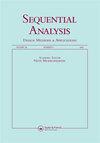多元正态分布和相关数据下向量均值的Wald序列检验
IF 0.6
4区 数学
Q4 STATISTICS & PROBABILITY
Sequential Analysis-Design Methods and Applications
Pub Date : 2020-07-02
DOI:10.1080/07474946.2020.1823196
引用次数: 0
摘要
摘要本文对多元正态分布、独立自相关数据和已知协方差矩阵进行了Wald序列概率比检验。针对自相关数据,提出了一种基于向量自回归移动平均(VARMA)类模型残差的方法。在这种方法中,在顺序测试中做出决定所需的平均样本量是基于截距常数的向量之间相对于误差协方差矩阵的Mahalanobis距离。考虑到二元正态分布的不同情况,进行了蒙特卡罗模拟。对于I型和II型错误的固定概率,结果表明,停止序列检验的估计平均样本量略大于Wald理论对自相关和独立数据的预期。在独立性假设下,SPRT估计的样本量也小于霍特林检验所需的样本量。结果表明,数据相关性结构的遗漏强烈影响序列检验的I型和II型误差。利用生铁生产过程的实际数据和多元VAR(1)模型,给出了质量控制领域的一个例子。本文章由计算机程序翻译,如有差异,请以英文原文为准。
On Wald’s sequential test for vector mean under multivariate normal distribution and correlated data
Abstract In this article Wald’s sequential probability ratio test (SPRT) is implemented for multivariate normal distribution, for independent and autocorrelated data and known covariance matrix. The methodology based on residuals from the vector autoregressive moving average (VARMA) class models is presented for autocorrelated data. In this approach the average sample size required to take a decision in the sequential test is based on the Mahalanobis distance between the vectors of the intercept constants with respect to the error covariance matrix. Monte Carlo simulations were performed considering different scenarios for bivariate normal distribution. For fixed probabilities of type I and II errors, the results showed that the estimated average sample sizes to stop the sequential test were a little larger than those expected by Wald’s theory for autocorrelated and independent data. Under independence assumption the SPRT estimated sample sizes were also smaller than the sample sizes required by Hotelling’s test. It was shown that the omission of the correlation structure of the data strongly affects the type I and II errors of the sequential test. An example in the quality control field is presented using real data from a pig iron production process and the multivariate VAR(1) model.
求助全文
通过发布文献求助,成功后即可免费获取论文全文。
去求助
来源期刊

Sequential Analysis-Design Methods and Applications
STATISTICS & PROBABILITY-
CiteScore
1.40
自引率
12.50%
发文量
20
期刊介绍:
The purpose of Sequential Analysis is to contribute to theoretical and applied aspects of sequential methodologies in all areas of statistical science. Published papers highlight the development of new and important sequential approaches.
Interdisciplinary articles that emphasize the methodology of practical value to applied researchers and statistical consultants are highly encouraged. Papers that cover contemporary areas of applications including animal abundance, bioequivalence, communication science, computer simulations, data mining, directional data, disease mapping, environmental sampling, genome, imaging, microarrays, networking, parallel processing, pest management, sonar detection, spatial statistics, tracking, and engineering are deemed especially important. Of particular value are expository review articles that critically synthesize broad-based statistical issues. Papers on case-studies are also considered. All papers are refereed.
 求助内容:
求助内容: 应助结果提醒方式:
应助结果提醒方式:


